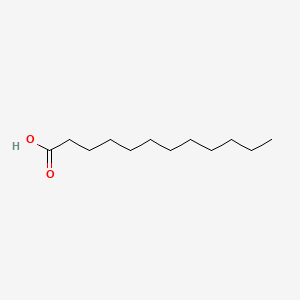lauric acid
lauric acid is a lipid of Fatty Acyls (FA) class. Lauric acid is associated with abnormalities such as Infection, Renal tubular disorder, Hypertensive disease, Obesity and Mycoses. The involved functions are known as Transcription, Genetic, Signal Transduction, Mutation, metaplastic cell transformation and Anabolism. Lauric acid often locates in Skin, Plasma membrane, Cytoplasmic matrix, Body tissue and Palmar surface. The associated genes with lauric acid are Gene Family, SLC33A1 gene, Homologous Gene, Open Reading Frames and P4HTM gene. The related lipids are Fatty Acids, Oleic Acids, Palmitates, Stearates and 9,11-linoleic acid.
Cross Reference
Introduction
To understand associated biological information of lauric acid, we collected biological information of abnormalities, associated pathways, cellular/molecular locations, biological functions, related genes/proteins, lipids and common seen animal/experimental models with organized paragraphs from literatures.
What diseases are associated with lauric acid?
lauric acid is suspected in Renal tubular disorder, Hypertensive disease, Infection, Renal vascular disorder, Obesity, Mycoses and other diseases in descending order of the highest number of associated sentences.
Related references are mostly published in these journals:
| Disease | Cross reference | Weighted score | Related literature |
|---|
Possible diseases from mapped MeSH terms on references
We collected disease MeSH terms mapped to the references associated with lauric acid
PubChem Associated disorders and diseases
What pathways are associated with lauric acid
There are no associated biomedical information in the current reference collection.
PubChem Biomolecular Interactions and Pathways
Link to PubChem Biomolecular Interactions and PathwaysWhat cellular locations are associated with lauric acid?
Visualization in cellular structure
Associated locations are in red color. Not associated locations are in black.
Related references are published most in these journals:
| Location | Cross reference | Weighted score | Related literatures |
|---|
What functions are associated with lauric acid?
Related references are published most in these journals:
| Function | Cross reference | Weighted score | Related literatures |
|---|
What lipids are associated with lauric acid?
Related references are published most in these journals:
| Lipid concept | Cross reference | Weighted score | Related literatures |
|---|
What genes are associated with lauric acid?
Related references are published most in these journals:
| Gene | Cross reference | Weighted score | Related literatures |
|---|
What common seen animal models are associated with lauric acid?
There are no associated biomedical information in the current reference collection.
NCBI Entrez Crosslinks
All references with lauric acid
Download all related citations| Authors | Title | Published | Journal | PubMed Link |
|---|---|---|---|---|
| Guo J et al. | Characterization of a novel esterase Rv0045c from Mycobacterium tuberculosis. | 2010 | PLoS ONE | pmid:20957207 |
| Zeiger K et al. | Lauric acid as feed additive - An approach to reducing Campylobacter spp. in broiler meat. | 2017 | PLoS ONE | pmid:28419122 |
| Ruiz M et al. | A cardiac-specific robotized cellular assay identified families of human ligands as inducers of PGC-1α expression and mitochondrial biogenesis. | 2012 | PLoS ONE | pmid:23056435 |
| Hu Z et al. | Three-dimensional noninvasive monitoring iodine-131 uptake in the thyroid using a modified Cerenkov luminescence tomography approach. | 2012 | PLoS ONE | pmid:22629431 |
| Huang QD et al. | Cyclen-based cationic lipids for highly efficient gene delivery towards tumor cells. | 2011 | PLoS ONE | pmid:21887233 |
| Trupp M et al. | Metabolomics reveals amino acids contribute to variation in response to simvastatin treatment. | 2012 | PLoS ONE | pmid:22808006 |
| Schlievert PM and Peterson ML | Glycerol monolaurate antibacterial activity in broth and biofilm cultures. | 2012 | PLoS ONE | pmid:22808139 |
| Dai C et al. | Formation of worm-like micelles in mixed N-hexadecyl-N-methylpyrrolidinium bromide-based cationic surfactant and anionic surfactant systems. | 2014 | PLoS ONE | pmid:25019152 |
| Lin Y et al. | Sodium laurate, a novel protease- and mass spectrometry-compatible detergent for mass spectrometry-based membrane proteomics. | 2013 | PLoS ONE | pmid:23555778 |
| Kaldensjö T et al. | Detection of intraepithelial and stromal Langerin and CCR5 positive cells in the human endometrium: potential targets for HIV infection. | 2011 | PLoS ONE | pmid:21738639 |
| Mumby PJ et al. | Grouper as a natural biocontrol of invasive lionfish. | 2011 | PLoS ONE | pmid:21731769 |
| Santosuosso M et al. | R5-SHIV induces multiple defects in T cell function during early infection of rhesus macaques including accumulation of T reg cells in lymph nodes. | 2011 | PLoS ONE | pmid:21483689 |
| Kenney J et al. | An antiretroviral/zinc combination gel provides 24 hours of complete protection against vaginal SHIV infection in macaques. | 2011 | PLoS ONE | pmid:21246052 |
| Wegmann F et al. | A novel strategy for inducing enhanced mucosal HIV-1 antibody responses in an anti-inflammatory environment. | 2011 | PLoS ONE | pmid:21253014 |
| Taha R et al. | Oxidative stress and mitochondrial functions in the intestinal Caco-2/15 cell line. | 2010 | PLoS ONE | pmid:20676402 |
| Kumar A et al. | Non-esterified fatty acids generate distinct low-molecular weight amyloid-β (Aβ42) oligomers along pathway different from fibril formation. | 2011 | PLoS ONE | pmid:21526230 |
| Munford RS and Varley AW | Shield as signal: lipopolysaccharides and the evolution of immunity to gram-negative bacteria. | 2006 | PLoS Pathog. | pmid:16846256 |
| Katsikis PD et al. | The cytokine network of acute HIV infection: a promising target for vaccines and therapy to reduce viral set-point? | 2011 | PLoS Pathog. | pmid:21852945 |
| Nawaz F et al. | The genotype of early-transmitting HIV gp120s promotes α (4) β(7)-reactivity, revealing α (4) β(7) +/CD4+ T cells as key targets in mucosal transmission. | 2011 | PLoS Pathog. | pmid:21383973 |
| Lepelley A et al. | Innate sensing of HIV-infected cells. | 2011 | PLoS Pathog. | pmid:21379343 |
